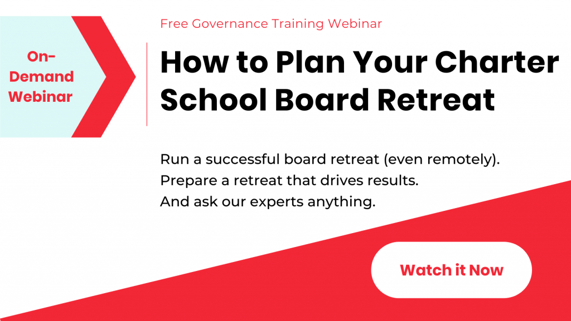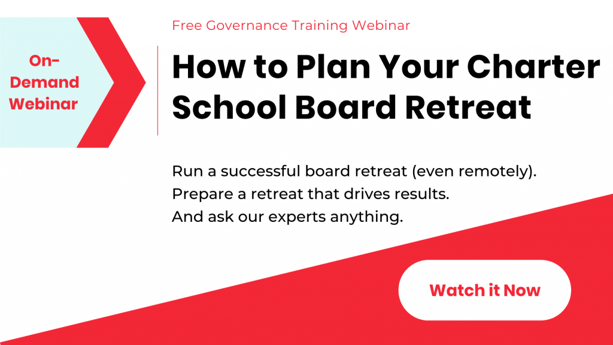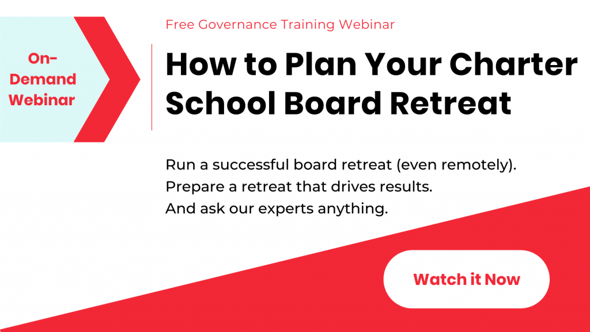
Leading Your Charter School Board’s Retreat Remotely
By now, your board is used to working remotely together. You’ve been hosting your board meetings remotely, either using BoardOnTrack or a combination of tools like Zoom and Google Docs.
But now it’s time to get ready for your board’s annual retreat. And this might be your first remote retreat.
Board retreats are the time to ensure your board engages in team building, professional development, and strategic planning.
And even in especially challenging times, and even when hosted remotely, a board retreat can help boost board member engagement.
So, if you’re running your retreat remotely, be ready for some new challenges and a few interesting benefits.
Deciding if you’ll hold your board retreat remotely
Everybody’s kind of in a different place in terms of vaccinations and, and comfort level for meeting in person.
We’ve seen a lot of boards run really great retreats this year, remotely. So if you’re hesitating because you’re not sure you can accomplish the same things in a remote retreat as you would in one or two days together in person, we’d encourage you to give it a try.
Here’s how hosting a board retreat remotely will be different than what you’ve done before
Even at this stage of the pandemic, holding an in-person retreat might not be possible for your board. Or, your board might be so used to meeting remotely that they simply prefer to host their retreat remotely as well.
Running a retreat remotely presents some new challenges and a few interesting benefits.
Avoid online meeting fatigue by scheduling your retreat wisely.
Be cognizant of Zoom fatigue, which we all are pretty aware of at this point.
People cannot be online and productive for the number of hours they might’ve been together in person.
But, board retreats generally require around eight hours of working time. And in the past, many retreats have run a full two days.
Even before the pandemic, charter school boards were increasingly moving away from the one- or two-day approach. Instead, breaking the work into two four-hour sessions.
Plan to do this work in even shorter bursts.
You might schedule an extended board meeting in one-hour or 90-minute blocks throughout the course of a day or two. Or, a series of evening sessions.
Your board members are likely already used to afternoon or evening meetings, and you can schedule your retreat agenda in smaller sessions in those same time windows.
Do what works for your team. Just don’t make it an online marathon.
And build in intentional and moments for email checking and health breaks and things like that. So that during the focus time you really have everybody’s attention.
There’s an upside to breaking your retreat into a series of shorter sessions.
Getting momentum and follow-through post-retreat is a really common problem.
An interesting benefit of having to break things up over a series of sessions means that committees and other working groups can go off, do some work, and return with work products for the rest of the board to respond to.
Building in this kind of scheduled accountability may help ensure that the great planning energy is actually turned into actions.
This approach to engaging your committees can help ensure your retreat ends with actionable plans.
Committees are the engines of the board. And usually, your retreat will end with priorities that the committees will turn into SMART goals, diving deeper into their focus areas than they could at the retreat.
So it works nicely to have the full board gathered for two or three hours. Then, give each committee clear next steps, and gather again the next day or week once each committee has done their work.
Does having multiple sessions create a potential attendance problem?
It is important to aim for 100% board member attendance at your retreat, no matter the format or schedule.
But remote retreats are still relatively new. There’s probably not a clear, black-and-white answer here.
Anecdotally, we’re seeing that breaking the retreat up into shorter sessions that are held remotely is actually helping with attendance. And even with the efficacy of the retreat.
Having a full in-person one-day board retreat is really high stakes in that, if one person misses that board retreat, they’ve missed everything.
If you have concerns with your team about engagement and attendance, reach out to us. Board member attendance and engagement problems tend to be symptoms of a larger issue within the board. Our team can help you try to find the root of the problem.
Plan and prepare well to get the most out of your full board’s time together.
To get the most out of people’s time and attention, especially in a series of shorter sessions, you’ll want to be even more intentional and deliberate about the agenda.
Be clear about what you absolutely need to cover.
Your Governance Committee will take the lead in planning the retreat agenda.
Still, get buy-in from your board about what they want to see on the agenda. Give them an opportunity to react to your proposed agenda, so they feel like the most important topics are there.
Then you can make it a half-day or break it into bite-sized sessions, and people will feel like their time together is time really well spent.
And, you’ll most likely need each committee to meet together in advance of your full board retreat.
Try to schedule those prep meetings far enough in advance of the full retreat that the committees have time to do what’s needed and be fully prepared.
Decide if and how you’ll incorporate training.
When running your retreat remotely, your decisions about incorporating board training might be different.
Board training has absolutely been an important part of the traditional in-person annual board retreat.
But when faced with limited time and attention in an online meeting format, you might look to replace in-person training with on-demand options. For instance, take a look at our free library of on-demand webinars.
This allows you to keep the live online meeting time focused on the actual work, and helps avoid Zoom fatigue.
You might even assign your team to review the resources around a key topic like financial oversight. (If you’re a BoardOnTrack member, you’ll have access to even more in the Resources hub.)
Then use your time together to discuss what you learned, address any lingering questions, and put your knowledge into action.
Comply with your open meeting laws as necessary, even when holding your retreat remotely.
In most locales, you will have to post your retreat online to be in compliance.
Open meeting laws vary from state to state, and are in constant flux right now due to COVID-19.
Check with your authorizer, legal counsel, or your state association to ensure that you are following the applicable laws and up-to-date guidance.
Five keys to a successful board retreat, remote or not
Whether you’re hosting your board retreat remotely or not, a successful charter board retreat relies on four key factors of preparation.
1. Complete a board assessment
If you take a board self-assessment, as you can do in BoardOnTrack, then you know where your board’s strengths are and where you’ve got work to do.
2. Complete a CEO evaluation
It’s important that your CEO gets a chance to reflect on the year, and to share their thoughts with you. You’ll want to clear the air before moving forward to finalize plans for the next school year.
You might then plan time at your retreat for your CEO to share thoughts about areas to strengthen and provide recommended approaches.
See how to run a CEO evaluation using BoardOnTrack.
3. Understand your charter school’s overall priorities
In advance of your retreat, make sure that at least your board chair and CEO are on the same page about your organization’s needs and priorities for the coming year.
4. Prep each board committee to play a role in your retreat
In addition to the Governance Committee leading the planning, each committee will play a role in your retreat.
At minimum, each committee will have time to report out on key information, answer questions, or lead strategic discussions on their areas of focus.
For example, perhaps your Finance Committee had the goal to “Create multiyear scenarios to improve salary scale and other benefits.”
Get our complete guide to active board committees.
5. Turn your discussion into actionable plans
The measure of success is this: Did we make it actionable?
Make sure you end your retreat with a set of actionable, measurable board goals.
Either following your retreat, or during the sessions you schedule in-between your full-board sessions, each committee will meet to turn your governance priorities and overall organizational priorities into actionable goals.
For instance, the Governance Committee meets to discuss the governance-related board development topics defined at the full retreat; the Finance Committee meets to dig into the budgetary and financial objectives.
They all do the work, away from the full board meeting, developing their SMART goals and action plans.
Learn more about putting goals into action at your retreat.

Sam Falk
Sam Falk was the Chief Customer and Product Officer at BoardOnTrack and is based in Concord, Massachusetts.



